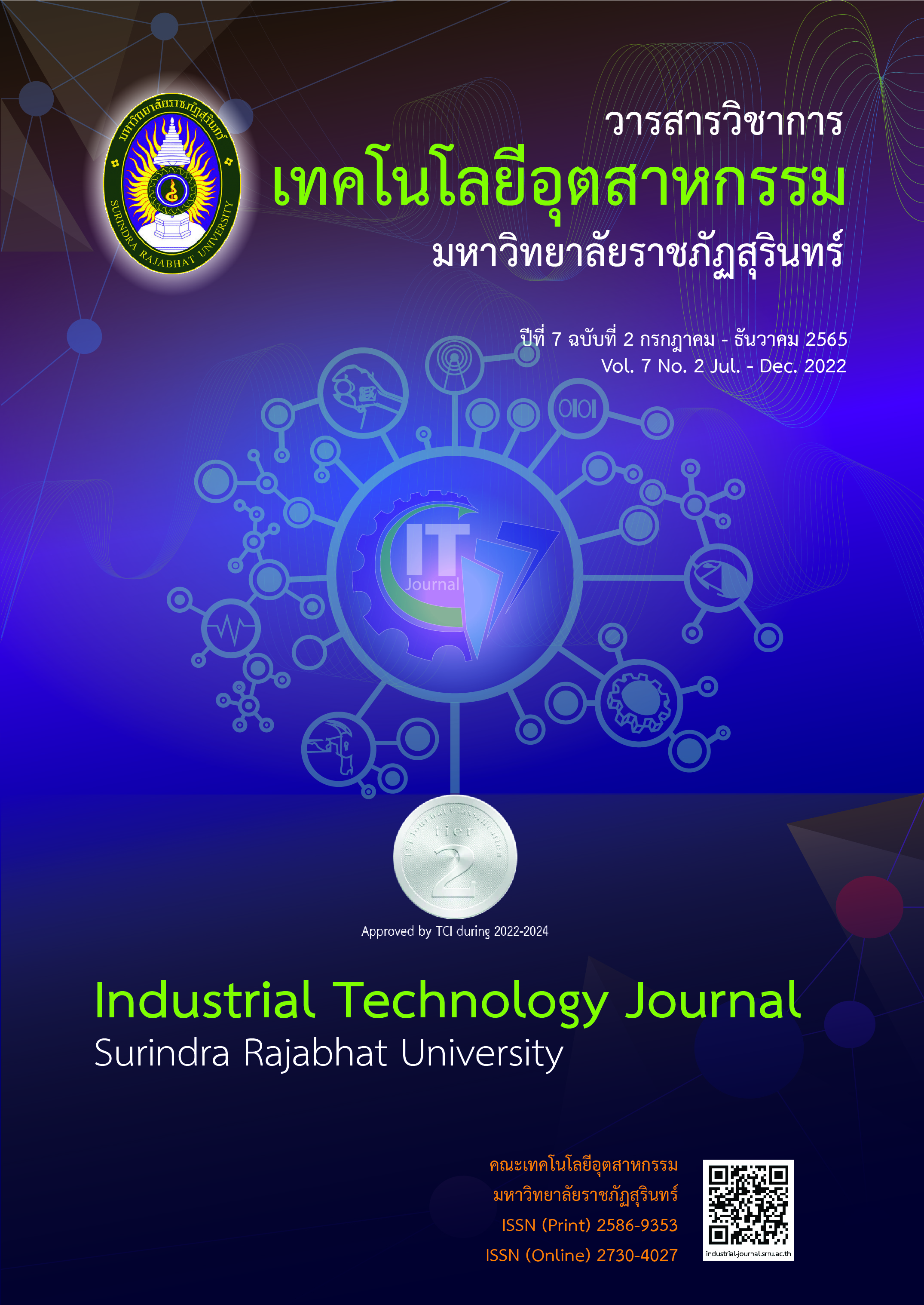Subject The Development of the Solar Energy Dryer for Food Processing Integrated with the Internet of Things (IoT) System Control -
Main Article Content
Abstract
The objectives of this research were to 1) develop, 2) investigate the efficiency, and 3) evaluate the quality of a solar energy dryer for food processing integrated with the Internet of Things (IoT) system control. The research tools consist of a table of efficiency testing and a quality assessment form. The research methods were followed by developing the solar energy dryer and getting it for efficiency testing and quality evaluation by the experts. The data analyzed with descriptive statistics included Percentage (%), Mean () and Standard Deviation (S.D.).
The research results found that:
1) Obtained the dryer, dimensioned width of 80, length of 120, and height of 140 centimetres, The roof formed with a dome made of transparent materials that allowed sunlight to access as well. The three types of systems for drying are only daylight or solar, only artificial light or electric and hybrid. There are integrated with the ventilators to reduce humidity and use IoT systems for checking and temperature control, along with solar panels for supplying the power to various devices.
2) The dryer efficiency could be summarized in 3 systems. 2.1) The results of dryer testing (using only sunlight or solar energy) showed that; the temperature was total Mean at 40 °C, the solar intensity at 421 (W/m2), and the period of solar energy drying system used for 2 hours. 2.2) The results of dryer testing (using only artificial light or electric energy) showed that; the temperature was total Mean at 40 °C, the total Mean of electric current was 1 A with 220 V and 240 W, and the period of electric energy drying system used for 3 hours. And 2.3) The results of dryer testing (using hybrid energy) showed that; the temperature was total Mean at 40 °C, the total Mean of electric current was 1 A with 220 V and 240 W, the solar intensity at 421 (W/m2), and the period of hybrid energy drying system used for 1 hour.
3) The overall quality of the dryer was at the highest level (= 4.78, S.D. = 0.26)
Article Details
References
จรัญ คนแรง และคณะ. (2557). โครงการบูรณาการวิชาการแก่สังคมเพื่อพัฒนาการเรียนการสอนการวิจัยตู้อบ
สับประรดอบแห้งโดยใช้พลังงานแสงอาทิตย์ของชุมชนนางแลจังหวัดเชียงราย โปรแกรมวิชาวิศวกรรม
พลังงานและเทคโนโลยีไฟฟ้า คณะเทคโนโลยีอุตสาหกรรม มหาวิทยาลัยราชภัฏเชียงราย.
ไทยโพสต์. (2565). ประโยชน์ของ Internet of Things (IoT). [ออนไลน์]. เข้าถึงได้จาก :
https://www.thaipost.net/main/detail/24835. สืบค้น 3 กรกฎาคม 2565.
ญาณกีรติ พลวิเศษ และคณะ. (2562). เครื่องอบสมุนไพรแบบอัตโนมัติด้วยไฟฟ้า.
วิทยานิพนธ์ สาขาวิชาเทคโนโลยี การจัดการอุตสาหกรรม คณะเทคโนโลยีอุตสาหกรรม
มหาวิทยาลัยราชภัฏบุรีรัมย์.
ไพโรจน์ เหลืองวงศกร. (2559). ระบบรักษาความปลอดภัยที่บานโดยใชESP8266 สารนิพนธ์หลักสูตรวิทยาศาสตร์
มหาบัณฑิต สาขาวิชาเทคโนโลยีสารสนเทศคณะวิทยาการและเทคโนโลยีสารสนเทศ
มหาวิทยาลัยเทคโนโลยีมหานคร.
วินัยธร ไพเมือง. (2562). ตู้อบแห้งพลังงานแสงอาทิตย์อัจฉริยะสำหรับธุรกิจชุมชน. การประชุมวิชาการระดับชาติ
เครือข่ายวิจัยสถาบันอุดมศึกษาทั่วประเทศ ครั้งที่ 13.
รัฐพงษ์ โป้เคน และ วิศิษศักดิ์ เสงี่ยมศักดิ์ (2563). ตู้อบกล้วยพลังงานแสงอาทิตย์.
วารสารวิชาการการประยุกต์ใช้เทคโนโลยีสารสนเทศ. 6(1). 48-57.
สุดธิดา อินทผล อุปวิทย์ สุวคันธกุลและโอภาส สุขหวาน. (2551). การพัฒนาเครื่องอบแห้งพลังงานแสงอาทิตย์.
วารสารวิชาการอุตสาหกรรมศึกษา. 2(1). 71-81.
สุชาติ ดุมนิล อัษฎา วรรณกายนต์ และสุพิมพา วัฒนสังขโสภณ. (2562). เครื่องอบพลังงานโซล่าเซลล์ควบคุมด้วย
อุณหภูมิที่เหมาะสมสำหรับวิสาหกิจชุมชน. วารสารวิชาการเทคโนโลยีอุตสาหกรรม มหาวิทยาลัย
ราชภัฏสุรินทร์. 4(3). 30-38.
ศิริวรรณ อาจบำรุง. (2562). ตู้อบแห้งพลังงานแสงอาทิตย์ประสิทธิภาพสูง. รายงานการวิจัย มหาวิทยาลัย
ราชภัฏมหาสารคาม.
อนิรุทธิ์ ต่ายขาว และ สมบัติ ทีฆทรัพย์. (ม.ป.ป.). เครื่องอบแห้งพลังงานแสงอาทิตย์ชนิดพาความร้อน
แบบธรรมชาติ และชนิดพาความร้อนแบบบังคับ วารสารวิชาการ มหาวิทยาลัยอิสเทิร์นเอเชีย
ฉบับวิทยาศาสตร์และเทคโนโลยี.

